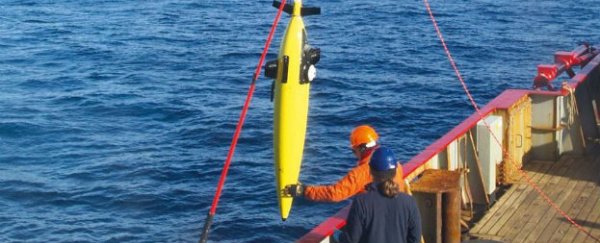Ice sheets on the coast of West Antarctica are rapidly melting and it's predicted that if they continue to collapse, sea levels will rise by at least 3 metres. Scientists have been keeping a close eye on the warm water near the coast, which they think is the main factor causing the ice to melt. But exactly how this is happening has remained a mystery, and now scientists from the California Institute of Technology in the US have obtained some important information on the melting Antarctic ice, with the help of three dolphin-like robots.
The gliders are 2 metres long - about the size of a bottle-nosed dolphin - and were deployed in the depths of the Weddell sea off Antarctica in 2012 to measure temperature and salinity. After two months of gliding with the ocean currents, they discovered that eddy currents - swirls of warm water - are reaching the shallow regions of the Antarctic sea, leading to melting coastal ice.
The findings, which are published in the journal Nature Geoscience, will help scientists to figure out how quickly the ice is melting and how this will affect rising ocean levels.
"Eddies are instabilities that are caused by ocean currents, and we often compare their effect on the ocean to putting a spoon in your coffee," said Andrew Thompson, environmental scientist and lead researcher, in a press release. "If you pour milk in your coffee and then you stir it with a spoon, the spoon enhances your ability to mix the milk into the coffee and that is what these eddies do. They are very good at mixing heat and other properties."
In the past, researchers have used ships to collect ocean data, but this method was expensive and limiting. The gliders are battery-powered and extremely energy efficient, meaning they can sample the ocean for much longer periods than large ships can.
The gliders dive just like dolphins, when batteries power a pump that pushes water into a compartment inside the glider, which makes it heavier than seawater and causes it to sink. When it's ready to surface again, the water is pumped into a bladder on the outside of the glider, making it more buoyant and causing it to rise.
Every few hours when the glider surfaces, it 'calls' the researchers through a mobile phone-like device, allowing them to immediately access the information it has collected.
The team now wants to use a more advanced glider to study the Drake Passage - a patch of ocean between the southern tip of South America and Antarctica. This narrow stretch of sea is known for its deep waters emerging at the surface, making it the ideal to study the carbon dioxide exchange between the atmosphere and the ocean.
"The Southern Ocean is the window through which deep waters can actually come up to 'see' the atmosphere," said Thompson. "It's a very special place for many reasons."
Watch this video to find out more about how the gliders work:
